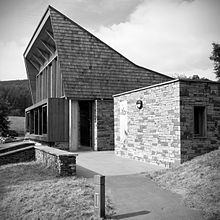Grizedale Hall
Grizedale Hall was a large mansion in Grizedale in the Lake District / Cumbria in northwest England . After two previous buildings, it was completely rebuilt in the neo-Gothic style in 1905 , served as the first British POW camp from 1939 to 1946 during World War II and was finally demolished in 1957.
Grizedale Hall (1905)
In 1903 the wealthy merchant and ship owner Harold Brocklebank from Liverpool acquired the Grizedale estate. He was born in 1853 as the third son of Sir Thomas Brocklebank, 1st Baronet. After the old mansion was demolished, Harold Brocklebank had Grizedale Hall completely rebuilt in 1905; the interior of the house was completed by 1907. The architects of the 40-room neo-Gothic house were Walker, Carter & Walker of Windermere, Cumbria . Brocklebank lived in Grizedale Hall with his wife Mary Ellen Brogden, three daughters and two sons until his death in 1936. Then the Forestry Commission took over the 6,000 acre estate with the manor house.
After it served as the first POW camp in Great Britain from 1939 to 1946, the property was vacant. Due to the high maintenance costs, the Forestry Commission auctioned off the fixtures, chimneys and stairs and then demolished Grizedale Hall in 1957. Only the single-storey extension with storage rooms on the east side of the house and the garden terrace remained. Some architectural remnants of the house such as the massive walls and stairs of the garden terrace and the gates of the property fence are still visible today. The parking lot of the visitor center of the Grizedale Forest National Park is located on the former inner area of the manor house.
No 1 POW Camp
During the Second World War, Grizedale Hall was requisitioned by the War Office and officially listed as "No 1 POW Camp (Officers) Grizedale Hall" since 1939 to accommodate some of the most outstanding German prisoner-of-war officers such as Field Marshal Gerd von Rundstedt . The camp around the manor house was equipped with watchtowers, a double barbed wire fence and about 30 huts that could accommodate around 300 prisoners. Since many of the prisoners of war had been rescued from sunken German submarines, it was popularly known as the "U-Boot Hotel".
One of the inmates was Otto Kretschmer , who was Germany's most successful submarine captain until his capture. The fighter pilot Franz Baron von Werra was initially imprisoned in Grizedale Hall and one of his famous escape attempts in 1940 inspired the story of the 1957 film One Came Through , in which Grizedale Hall was used as a film set shortly before the demolition. Other known prisoners were Rear Admiral Hans Voss , General of the Waffen-SS Maximilian von Herff and U-boat captain Werner Lott . The last prisoners were released in 1946 to be returned to Germany and Austria. The Grizdeale Hall prisoner of war camp also inspired the 1970 war film Outbreak of 28 and is the setting for the 1989 novel "A Cage of Eagles" by James Follet.
The Yan
A new building for the Grizedale Forest Visitor Center, called "The Yan" (Cumbrian dialect for "One"), was built in 2008 as an extension of the remaining storage room extension of the abandoned Grizedale Hall. The construction of wood and natural stone was designed by Sutherland Hussey Architects from Edinburgh and opened on June 23, 2008 by Lord Clark of Windermere .


